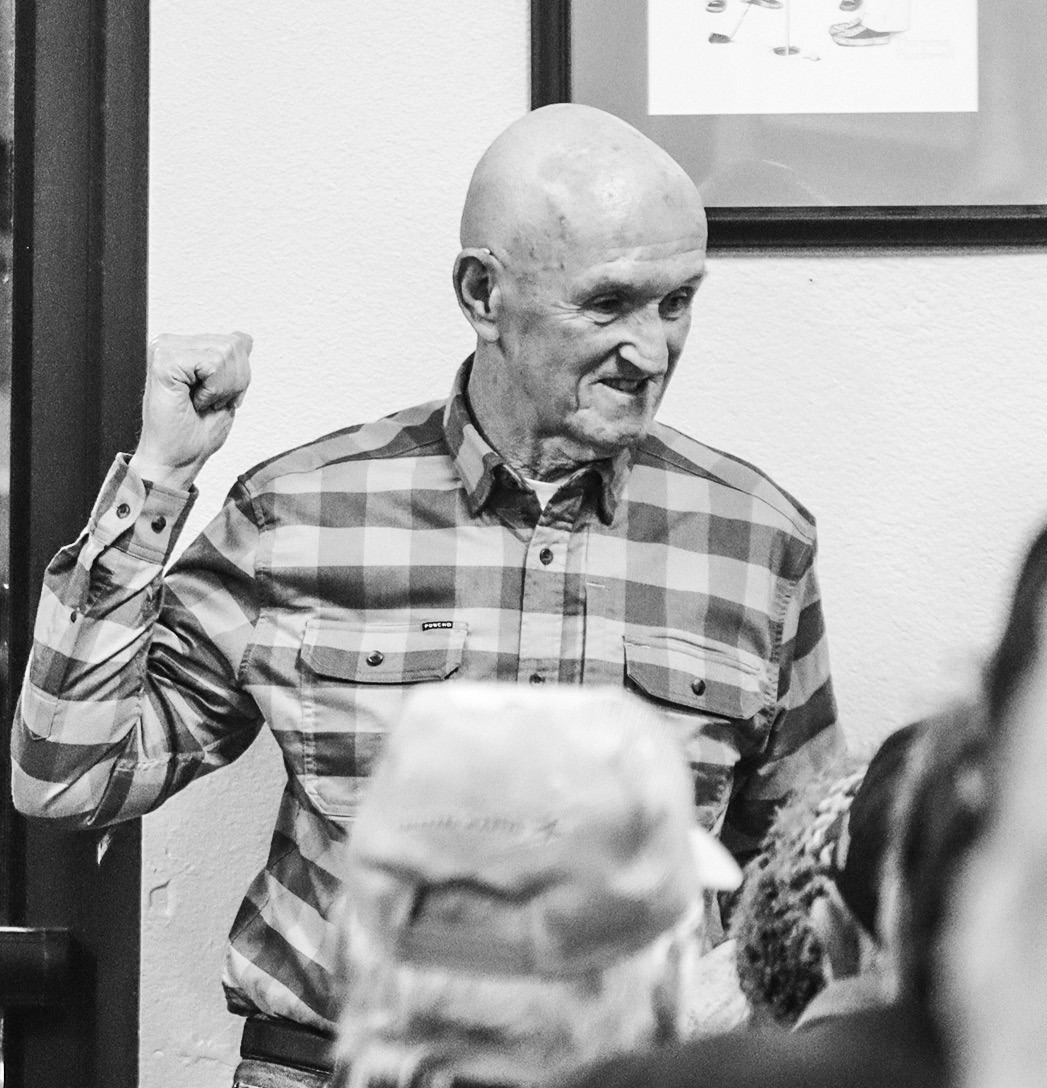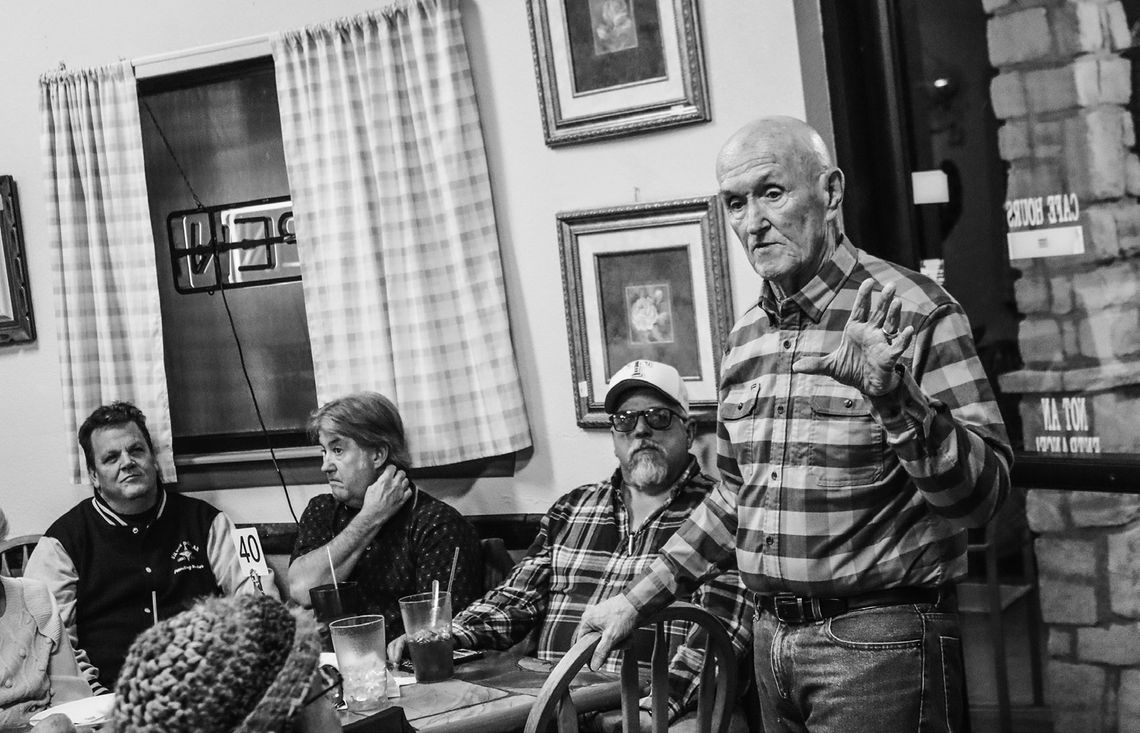Vietnam veteran Doug Petersen speaks at Moe’s Country Kitchen
AZLE —The Silver Dollar Classics Car Club took a different approach to last Tuesday’s meeting. Along with a quick flyby of information about the organization’s third-annual Vietnam veteran benefit car show, Doug Petersen, a noted public speaker and former “DUSTOFF” pilot, told his story to a packed room at Moe’s Country Kitchen. An estimated 50 people arrived to listen to Petersen and enjoy a meal at the local restaurant.
Petersen spoke to the club and described his experiences joining the military and surviving being shot down twice over Vietnam. Petersen spent more than 20 years as an aviator in the United States Army where he completed over 1,000 combat hours and evacuated nearly 1,300 wounded soldiers.
Originally from Virginia Beach, Virginia, in 1969 he enlisted in the United States Army, going from high school to fly school. After basic training in Louisiana, he came to Texas to train as a pilot at Fort Wolters in Palo Pinto and Parker Counties.
“Here we are a bunch of teenagers, maybe 20 years old, flying these little helicopters all over Palo Pinto County,” Petersen said. “I mean, we were everywhere.
We called them a little mosquito and it was a little twopassenger thing, a tiny little thing, a little orange bubble.
We called it the rubber band airlines, because what drove the transmission was eight fan belts. If the fan belts broke, things were not looking good for you.”
From Fort Wolters, Petersen was transferred to Fort Rucker, now called Fort Novosel, in Alabama for advanced training. There, he trained to be a gunship pilot.
“I’ve got rockets and I’ve got mini guns, and I’ve got grenade launchers and I’m just having a blast of a time in lower Alabama blowing up trucks and stuff down range,” Petersen said. “So, I thought I was pretty cool.”
When he got to Vietnam in 1970 and was instead assigned to fly a Huey as a DUSTOFF pilot, Petersen said he couldn’t believe it.
“Little did I know how rewarding that decision was going to be for me,” Petersen said. “I got to fly a mission that had meaning and purpose, not that the others didn’t, but I got to fly a mission that saved lives.”
The Huey held two pilots, a crew chief and a medic.
DUSTOFF helicopters were not permitted to have guns, apart from the M16 rifles and sidearms carried by its crew for patient protection. It served strictly as an air ambulance. DUSTOFF crews would airlift wounded soldiers from all sides while under fire. The nickname DUSTOFF was first used as a call sign by the U.S. Army’s 57th Medical Detachment because of the large amount of dust kicked up by the chopper as it landed to pick up the injured from the battlefield.
Petersen said of the 3,400 total DUSTOFF crew members that served over Vietnam War, about one-in-three were killed or injured. Despite the dangers, the crews would fly day and night through good weather and bad in order to quickly get injured allies and even enemy combatants to safety.
“Those 3,400 flew nearly 500,000 missions and evacuated 900,000 patients,” Petersen said. “That one U.S. soldier that got to come home OK, he got to have a family, who had a family.
So, you see, the 3,400 just didn’t impact 900,000 — it impacted multi-millions internationally.”
Of all the aircraft that went down, Petersen said roughly half were the result of enemy fire. The other half were due to bad weather. He recounted stories from his flight school peers who were shot down in action and another who had flown into the side of a mountain during a blinding rain.
Petersen said he did not remember much from his first time being shot down, but that the second incident has always stuck with him.
“The second time I got shot down, I was the aircraft commander,” Petersen said. “We flew directly over the (Viet Cong). He took his AK-47 pointed directly up in the sky as I flew over top of him and unloaded his magazine and we took 25 hits. So, things get exciting at this point, as you can imagine. Now the mission was to get the crew to safety.
Before the aircraft crashed into the jungle, I was able to fly to a small area to get down on the ground before the engine quit. I wanted to get there before the engine quit.
Now I didn’t know where I was landing. Whether it was with the good guys or the bad guys, or who was there, there was no choice. There was, the only option was to get there.
So, I got there and landed, and we got picked up about an hour later by another crew.”
Among Petersen’s most dangerous operations were voice missions. During these flights, DUSTOFF crews would lower a jungle penetrator via a long cable. The torpedo-shaped device would unfold and injured soldiers could be strapped and hoisted to relative safety.
“We were sitting ducks because you’re sitting in the enemy territory,” Petersen said.
“You were sitting there at a harbor for 20 to 30 minutes on average and you’ve got a patient on board.”
For nearly a decade, Texas Sen. John Cornyn and former Washington Congressman Derek Kilmer have fought for DUSTOFF pilots to be recognized with the Congressional Gold Medal, the country’s highest civilian honor. These efforts did not bear much fruit until recently, when the DUSTOFF Crews of the Vietnam War Congressional Gold Medal Act was signed into law by former President Joe Biden in September. The U.S. Mint will strike just one gold medallion, which will be displayed at Fort Sam Houston in San Antonio in honor of every DUSTOFF crew member. Petersen and other pilots played a critical role in lobbying to get their due recognition.
“I belong to an organization called the Vietnam DUSTOFF Association,” Petersen said.
“We, as an organization, got together, and we asked a law firm in Washington, D.C., would you help us with lobbying Congress? And, oh, by the way, we can’t pay and they said, ‘Yes.’ So, 13 of us with this law firm went to Washington, D.C., and they had made all these arrangements for us to meet with congressmen and senators and congressional staffers and legislative assistants and all those and we knocked on doors day after day. I went to Washington three times and I knocked on doors and shook hands and told my story.”
After retiring from the armed services in 1989, work would eventually bring Petersen back to Texas.
Today, he continues to live in Benbrook and has made appearances on the local CBS Channel 11 news, has given a TEDx talk, appeared on popular podcasts and more.
The SDCCC plans to hold its Vietnam Veterans Day Car Show March 29 at Eagle Mountain Marina.
The club presented a check for $7,500 to the Tarrant County Vietnam Memorial Foundation using money it raised during its 2023 car show. In 2024, the club presented a $10,000 check to the foundation.
“I think this is a great organization,” Petersen said in an interview with the Tri-County Reporter. “So many times the Vietnam veterans were kind of ignored in the past and when we have organizations like this one come together and with a purpose behind it and support veterans, whether it’s the Vietnam veterans or any other veterans’ group, I think that’s fantastic. This is what Americans need to be doing is supporting other veterans. I just think that this is a great honor, great privilege, to be able to do that today.”

Petersen tells his story and gestures while the crowd listens in.




